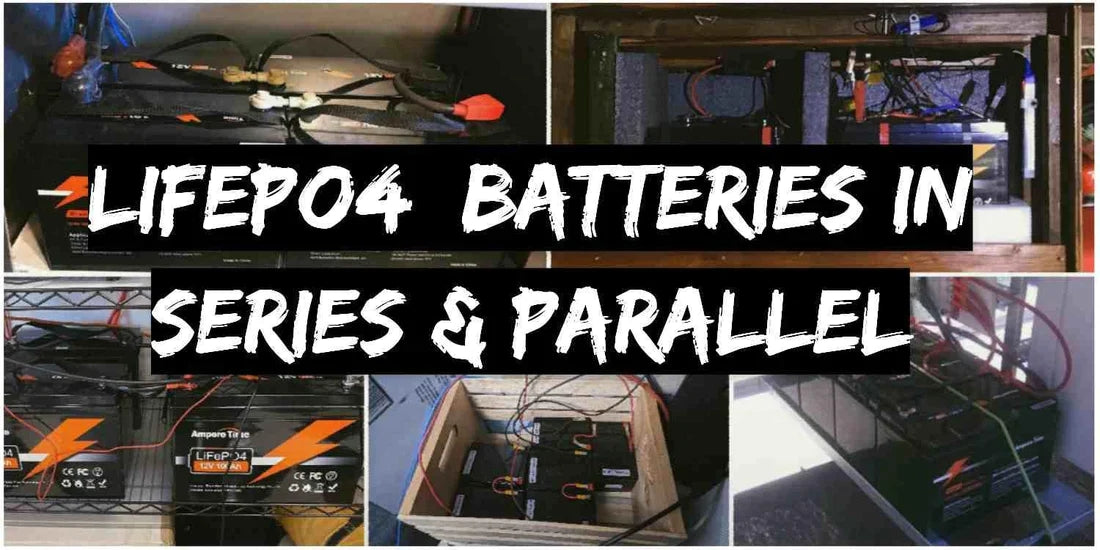Part1: Series Connection of LiFePO4 Batteries
1.1 Definition of Series ConnectionSeries connection of LiFePO4 batteries refers to the arrangement of multiple cells in a sequence to increase the total voltage. In this configuration, the positive terminal of one cell is connected to the negative terminal of the next cell, and so on, until the desired voltage is achieved.
 The total capacity of the battery pack remains the same as that of an individual cell, but the voltage output is increased. Series connection is commonly used in applications that require high voltage, such as electric vehicles, solar power systems, and backup power supplies for buildings.
The total capacity of the battery pack remains the same as that of an individual cell, but the voltage output is increased. Series connection is commonly used in applications that require high voltage, such as electric vehicles, solar power systems, and backup power supplies for buildings. 1.2 Advantages of Series Connection
Series connection of LiFePO4 batteries offers several advantages, including:
Higher Voltage Output: By connecting multiple cells in series, the overall voltage output of the battery pack is increased, making it suitable for applications that require higher voltage. For example, 4 sets of 12.8-volt batteries can deliver a total energy output of 51.2 V.
More Efficient Energy Storage: In a series-connected battery pack, each cell shares the load evenly, ensuring that each cell is charged and discharged at the same rate. This results in more efficient overall energy storage.
Series connection is ideal for applications that demand high voltage, such as electric vehicles and solar power systems. It enables efficient energy storage and ensures a uniform distribution of charge and discharge within the battery pack.

1.3 Disadvantages of Series Connection
Series connection of LiFePO4 batteries also comes with some disadvantages, including:
Risk of Overcharging: When cells in a series-connected battery pack have different capacities or ages, they can discharge at different rates, leading to an imbalance in the pack's voltage. This can result in some cells being overcharged, which can be dangerous and reduce the overall battery pack's lifespan.
Reduced Capacity: In a series-connected battery pack, the total capacity remains the same as that of an individual cell. Therefore, connecting cells in series does not increase the overall capacity of the battery pack.
To avoid these issues, it is essential to ensure that all cells in the series-connected pack have similar capacities and ages. Additionally, proper charging and monitoring of the pack's voltage are crucial to prevent overcharging and ensure efficient operation of the battery pack.
Part 2: Parallel Connection of LiFePO4 Batteries
2.1 Definition of Parallel Connection
Parallel connection of LiFePO4 batteries refers to the connection of multiple cells by linking their positive and negative terminals together to increase the overall capacity of the battery pack.
 In this configuration, each cell shares the load evenly, resulting in higher current output and, consequently, an increase in the overall capacity. The voltage output of the battery pack remains the same as that of an individual cell. Parallel connection is commonly used in applications that require high capacity, such as backup power supplies for buildings, off-grid solar power systems, and electric vehicles.
In this configuration, each cell shares the load evenly, resulting in higher current output and, consequently, an increase in the overall capacity. The voltage output of the battery pack remains the same as that of an individual cell. Parallel connection is commonly used in applications that require high capacity, such as backup power supplies for buildings, off-grid solar power systems, and electric vehicles.
2.2 Advantages of Parallel Connection
Parallel connection of LiFePO4 batteries offers several advantages, including:
Increased Capacity: By connecting multiple cells in parallel, the overall capacity of the battery pack is increased, making it suitable for applications that require high capacity. For example, if 4 batteries with 12.8 V and 100 Ah are connected in parallel, the voltage remains the same while the capacity increases to 400 Ah.
Reduced Risk of Overcharging: In a parallel-connected battery pack, each cell is charged and discharged independently, reducing the risk of overcharging or undercharging of individual cells. This contributes to the safety and longevity of the entire battery pack.
The parallel connection is suitable for applications that require high capacity, such as backup power supplies for buildings and off-grid solar power systems. It enables efficient energy storage and ensures a uniform distribution of charge and discharge within the battery pack.
2.3 Disadvantages of Parallel Connection
Parallel connection of LiFePO4 batteries also comes with some disadvantages, including:
Lower Voltage Output: In a parallel-connected battery pack, the overall voltage output remains the same as that of an individual cell. Connecting cells in parallel, therefore, does not increase the total voltage of the battery pack.
Less Efficient Energy Storage: Since each cell in a parallel-connected battery pack is charged and discharged independently, there may be variations in the state of charge of each cell, leading to less efficient energy storage.
To avoid these issues, it is essential to ensure that all cells in the parallel-connected pack have similar capacities and ages. Additionally, proper monitoring of the pack's voltage and state of charge is crucial to prevent undercharging or overcharging and ensure the efficient operation of the battery pack.
Part3: Comparison between Series and Parallel Connection of LiFePO4 Batteries
In this part, we explain the similarities and differences between series and parallel connection.
Similarities:
① Ability to Increase Overall Battery Performance: Both series and parallel connection of LiFePO4 batteries can increase the overall performance of the battery pack. In series connection, the voltage output of the battery pack is increased, while in parallel connection, the capacity is increased.
② Use in Various Applications: Both series and parallel connection are utilized in a wide range of applications such as RVs, boats, and solar-powered homes. They can also be used in electric vehicles and other off-grid systems.
Differences:
① Voltage Output: Series connection of LiFePO4 batteries increases the total voltage output of the battery pack. For example, when four 12V batteries are connected in series, the output voltage of the battery pack becomes 48V. In contrast, parallel connection of LiFePO4 batteries increases the overall capacity of the battery pack, but the voltage output remains the same as that of an individual cell or battery.
② Capacity: Parallel connection of LiFePO4 batteries increases the total capacity of the battery pack. For example, if 4 batteries with 100 Ah are connected in parallel, the total capacity of the battery pack becomes 400 Ah. On the other hand, series connection of LiFePO4 batteries does not increase the total capacity of the battery pack, only the voltage output.
③ Efficiency: Parallel connection of LiFePO4 batteries is generally more efficient than series connection because each cell or battery is charged and discharged independently. This ensures that the entire pack is not affected if one cell or battery fails or gets damaged. In contrast, the failure or damage of a cell or battery in a series-connected pack can affect the performance of the entire pack.
④ Cost: Parallel connection of LiFePO4 batteries is generally more expensive than series connection because additional wiring and hardware are required to ensure proper operation and safety of the pack. However, the increased capacity and efficiency can justify the additional costs in some applications.
Both series and parallel connection of LiFePO4 batteries offer distinct advantages depending on the specific requirements of the application. Proper consideration of these factors is essential to design an efficient and safe battery system.
In summary, the choice between series and parallel connection of LiFePO4 batteries depends on the specific requirements of the application. If a high voltage output is needed, series connection is the right choice. If a high capacity is required, parallel connection is the best option. Both configurations have their pros and cons, but they both offer the opportunity to increase overall battery performance and are commonly used in various applications such as RVs, boats, and solar-powered homes. When selecting a configuration, it is essential to consider factors such as voltage output, capacity, efficiency, and costs to determine which configuration best suits your specific requirements.
Points to Consider in Parallel Connection and Series Connection of LiFePO4 Batteries:
-When connecting LiFePO4 batteries in parallel, several points should be considered to ensure optimal performance and safety:
Uniformity: It is crucial to use cells or batteries with the same specifications, including capacity and age, in a parallel connection. Mismatched cells can lead to imbalances during charging and discharging, increasing the risk of battery failure.
Balancing: Monitoring the state of charge of each cell or battery is essential to maintain balance and prevent overcharging or undercharging of individual cells or batteries. This helps ensure the longevity and safety of the entire battery pack.
Wiring: Proper wiring of the parallel connection is critical for efficient operation and the safety of the battery pack. Incorrect wiring can lead to short circuits or other hazardous conditions.
-When connecting LiFePO4 batteries in series, the following points should be considered:
Uniformity: As with parallel connections, it is necessary to use cells or batteries with the same specifications, including capacity and age, in a series connection. Mismatched cells can result in an uneven distribution of voltage, leading to overcharging or undercharging of individual cells or batteries.
Charging: In a series connection, there is a risk of overcharging if one cell or battery reaches its full charge before others do. To prevent this, a Battery Management System (BMS) is recommended to monitor the voltage of each cell or battery in the series connection.
Safety: In a series connection, the total voltage output is increased, which can pose a higher risk of electrical shock. Proper insulation and grounding of the battery pack must be considered for safety purposes.
Furthermore, it is not recommended to connect old and new batteries (purchased 3-6 months apart) as they may have different internal resistances that could affect the overall performance of the battery pack. It is also essential to use batteries with consistent performance and never mix lithium-ion batteries of different brands, capacities, or types. Finally, always pay attention to the polarity of the batteries to avoid voltage drops or other hazards.
In conclusion
Both parallel and series connection of LiFePO4 batteries offer the opportunity to increase the overall battery performance and are commonly used in various applications. However, it is essential to consider the points to be observed when connecting these batteries to ensure optimal performance and safety. Uniformity, balancing, and proper wiring are crucial for parallel connections, while uniformity, charging, and safety must be considered for series connections. Additionally, it is important to avoid connecting old and new batteries, use batteries with consistent performance, and pay attention to the battery polarity. By adhering to these precautions, we can ensure the efficient operation and safety of our LiFePO4 battery packs.








